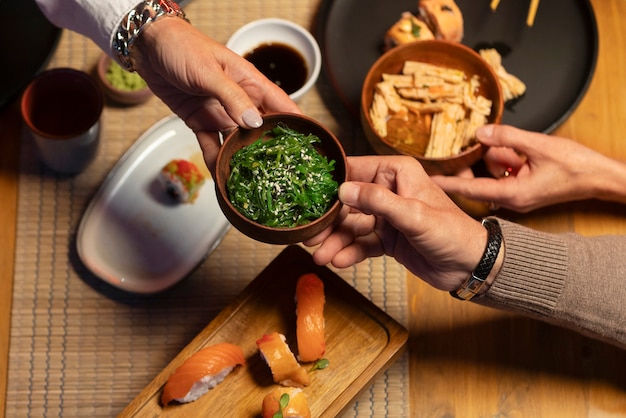
Ever wonder why Japanese men and women maintain their youthful look and stay healthy even as they age? Or how they seem to have such radiant skin and long lives? The secret lies in their diet, which is rich in antioxidants—key nutrients for overall health and beauty. Here, we’ll share some Japanese methods for getting more antioxidants into your meals, so you too can enjoy the benefits of a healthier, more youthful appearance.
### 5 Japanese Methods to Get More Antioxidants in Your Meals
**1. Green Tea**
Green tea is packed with antioxidants and is a staple in the Japanese diet. Drinking green tea 2 to 3 times a day can help protect your skin and body from inflammation and free radical damage. It’s also great for reducing the risk of severe diseases like cancer, heart issues, and diabetes. Start your day with a cup of green tea to boost your energy and metabolism, and promote healthier, glowing skin.
**2. Seafood**
Seafood, including fish, is another cornerstone of the Japanese diet. It’s rich in high-quality protein and omega-3 fatty acids, which are vital for heart health, brain function, and reducing inflammation. Fish like salmon, tuna, and mackerel help keep skin youthful by maintaining collagen levels and promoting shiny, healthy hair. Eating fish regularly is linked to fewer heart problems, better brain health, and prolonged longevity.
**3. Green Vegetables**
Japanese meals often include a variety of green vegetables, and for a good reason. Veggies like kale, broccoli, and Brussels sprouts are loaded with essential nutrients and antioxidants. These foods support weight loss, improve immune function, and help prevent chronic diseases. Importantly, Japanese cooking methods like light steaming ensure that these vegetables retain their nutritional value.
**4. Limited Red Meat Intake**
While red meat has its benefits, it’s also high in saturated fats, which can increase cholesterol levels and lead to cardiovascular diseases. The Japanese eat red meat in moderation to reap the benefits of its nutrients without the health risks. They also avoid other fatty foods in favor of healthier options.
**5. Healthy Eating Habits**
Japanese people follow some unique eating habits that contribute to their overall health. For example, they eat until they are 80% full (a practice called “Hara Hachi Bu”) and serve their meals in small bowls, which helps control portion sizes. Drinking a glass of water first thing in the morning to cleanse their digestive system is another common practice.
**Krill: A Sustainable Food Source**
Krill, small shrimp-like creatures, are commonly consumed in Japan. They are rich in proteins, low in fat, and packed with omega-3 fatty acids and antioxidants. Krill oil is an excellent alternative to fish oil and is more easily absorbed by the body. It’s shown to benefit heart health, reduce inflammation, and even help manage symptoms of arthritis.
**Conclusion**
Japanese dietary habits and food choices contribute significantly to their health and youthful appearance. Including these antioxidant-rich foods in your diet can help you achieve similar benefits. So, add more green tea, seafood, and green vegetables to your meals, limit red meat, and adopt healthier eating habits to enjoy a longer, healthier life.